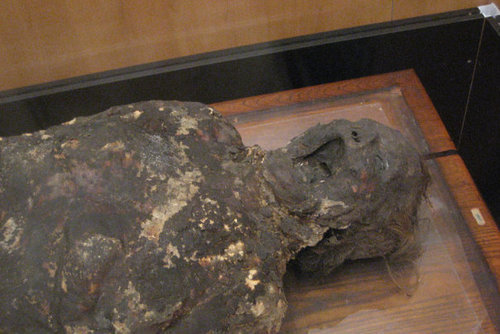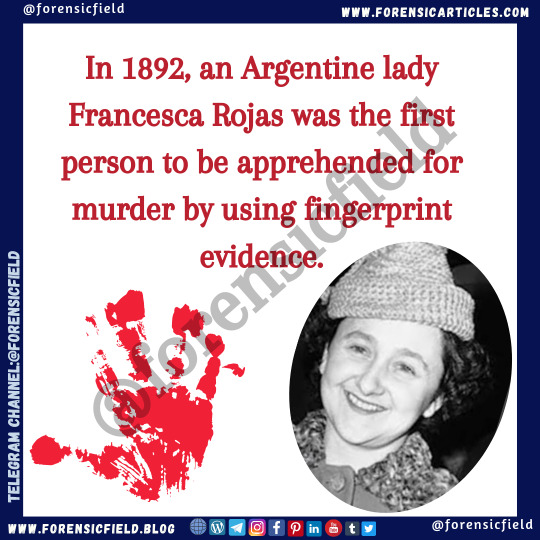#forensic science
Photo

Luminol is a powder which is made up of oxygen, hydrogen,nitrogen, and carbon. It glows luminous blue when it comes into contact with blood, even minuscule amounts of blood and even after the area has been cleaned. The glow of luminol only lasts for around 30 seconds but it can be captured through a camera. It’s often used as a last resort because the reaction can destroy the evidence.
2K notes
·
View notes
Text
Forensic Odontology Overview

Forensic odontology is a subspecialty of dentistry that has its main focus on the identification of deceased victims. In simplest terms, there are two aims in forensic dentistry. The first one is the identification of the dead, and second is the identification of an assailant who has used his or her teeth as a weapon. But how? Let's see.
Let's start with corpse identification. Teeth can be used to identify corpses, as no two oral cavities are alike, and teeth are unique to an individual. The dental evidence of the deceased recovered from the crime scene is compared with ante-mortem records for identification. This is used in cases such as mass casualties, burn victims, or severely disfigured/decomposed corpses.
Forensic odontology can also be used to determine things like age, race, and sex. In cases where there is no blood or other DNA sources, teeth can also be used.
Age is determined by looking at X-rays of the permanent teeth and tooth roots within the bone. The crown of a tooth forms first, followed by the root, and scientists estimate age by comparing the stage of tooth formation in the X-rays and bone with known dental growth standards.
Race is found by comparing the shapes of the different teeth. Determining race using teeth isn't easy, but using common dental characteristics as indicators (like Caucasoids usually having narrow “v-” shaped arch giving rise to crowding of teeth) we can get a good guess.
To determine sex, we rely on sexual dimorphism. Generally, male teeth have significantly greater quantities of dentine than females, while female teeth are found to have greater enamel thickness than male teeth. This isn't always fully accurate, but when combined with other factors, it helps give an idea.
None of these are perfect, but they can help give us a good approximate description, which is better than none.
Now, Bite Mark analysis.

There's 4 steps to bite mark analysis. Photographs, saliva swabbing, impressions, and tissue samples.
In order to make a good comparison, a balanced, color, scale photograph should be made of the defendant’s teeth (which can be used for testimony in court) and of the victim’s bite. Because the dental expert will need to know the scale shown in the picture, some method of measurement (such as a ruler or tape measure) photographed alongside the bite mark and the defendant’s teeth is necessary. A plaster cast of the defendant’s dental impressions can also be used to prepare a plastic overlay. The plastic overlay is used to mark the points of contact and forms a representation of defendant’s bite marks or a pattern of the cutting edges of defendant’s teeth. This representation can then be compared with a scaled photograph of the bite mark on the victim as a means of determining common points of identification.
If the bite area was swabbed and saliva recovered, and it was a positive match to the subject, that could help identify the assailant, but it's not often that DNA can be recovered.
Bite analysis has its issues, as tooth marks are not always transfered accurately, and sometimes there's not enough difference in bite marks to tell reliably. Bitemark analysis is more often used for excluding someone as a potential assailant. Say the mark shows imprint of fully intact frontal incisors, and the proposed biter does not have all their front teeth. This means that the person being accused is not the probable assailant. This could also be used to tell if the bite was self-inflicted. But bite mark analysis is often not admissible due to it having been found to be unreliable in some cases. People have been rightly and falsely convicted because of it, and it can be an unreliable method for forensic examination.
As with all areas of forensics, it's under dispute for its reputability. Bite mark analysists have been shown to be unable to consistently agree on whether the bitemark was even human. Even minor distortions could lead to the mark matching a number of people.
And here's a little bit of interesting history I came across in my travels :)
There are many "first" uses of forensic odontology in history across the web, but as far as I can find the first documented use of teeth for identification began during 66 AD, with the Agrippina and Lollia Pauline case. (There's a bit to it, find it here.)
Recorded forensic identification in India started in 1193, where Jai Chand, a great Indian monarchy, was destroyed by Muhammad's army, and Jai Chand, Raja of Kanauji was murdered and he was identified by his false teeth.
Dr Ascor Amoedo is reputed as the father of forensic odontology and documented the first case of dental identification in which many individuals lost their lives in a disaster. 126 people were charred to death due to a fire accident in Paris 1897, and were identified using their teeth.
In 1979, a double bite mark played an important role in convicting Ted Bundy of murder as he'd bitten one of his last victims.
#forensics#forensic science#forensic ondontology#dentists#dentistry#sherlock#deductions#science#mortuary science#dexter#criminology#criminals#criminal minds#criminal#criminals minds#woo science#police#idk im kinda using everything#orthodontics#orthodontics near me#AHHAHA#why is that a tag#forensic odontology#odontology#teeth#tma#spencer reid#help im so tired#did this make sense someone tell me it does#history
81 notes
·
View notes
Text

Best criminal minds character❤️❤️❤️
55 notes
·
View notes
Text


24.03.2024
.
I did a bit of forensic work and ignored the essay I have due in 3 weeks 🥲
I haven’t really been doing the best mentally so I’m taking it all one step at a time (studying enough to keep me from falling too far behind, but not enough to burn me out). Friendly reminder: there is no shame in prioritising your mental health!
And yes, my pen is shaped like a syringe (it used to have red liquid inside but it dried up :/)
#study#study aesthetic#study blog#study motivation#studyblr#studyspo#forensic notes#forensic science
63 notes
·
View notes
Video
My husband has been the victim of 1 crime per semester😂
#video#tiktok#tiktoks#funny#lmao#wtf#school#college#university#forensic science#forensic science major#forensic science majors#homework#dubbyhocklesticks
464 notes
·
View notes
Text
mfkers will want to study forensic science and still be squeamish/afraid of gore
(im mfkers)
58 notes
·
View notes
Text
This is how i feel studying forensic science and criminal investigation knowing I am never going through the security clearance for the FBI lmao (this post might just be it)

61 notes
·
View notes
Text

Hello, everyone! This spring will be busy for me (mostly because of uni stuff) so I will not be so active here for a while. BUT I still made one thing and it's game mockup about Tia and Luna (here called Elea & Agnieszka)!

So story is about two sisters from Europe - one prosecutor (graduated) and the second is forensic science student. They both travel to USA for internships but instead of doing practice in human world they isekai find themselves in the pony world (pre-alicorn era).

Not to waste a time, girls decide to apply their knowledge about law and enforcement into practice since local tribes - pegasi, unicorns, earth ponies - don't get along at all.

The game is a visual novel but has a lot of interaction elements like shooting from a gun, taking photos, collecting and examining evidence, debating (like in ace attorney), using smth similar of real softwares that forensic scientists use bc i don't want to be sued haha but TruView Cloud is real and I used it only as visual example.
I had this idea for a pretty long time and finally I managed to properly visualize it. I had a lot of fun headcanoning (and still have) so maybe in the future I will make a couple of more arts relating to this story and those girlies.
And for now - bye!
#mlp#mlp fim#game mockup#clip studio pro#fandom#digital drawing#digitalart#digital painting#law enforcement#visual novel#novel#prosecutor#forensics#princess celestia#princess luna#forensic science#forensic scientist#law
27 notes
·
View notes
Text
forensic science class shenanigans
In Junior Year (3rd) of High School I took a forensic science class. Normally classes had around 30 kids, but this was a new class at the school so there was only 15 weirdos in this one.
Loved the class, loved the teacher, learned a lot. Here's what happened.
Found out how absolute shit human memory is
Found out what bugs will eat me when I die
CUE existential crisis
Talked A LOT about geometry and what blood spatters can tell you
Talked about how if you purposely use your nondominant hand to kill someone, you can tell they are using the wrong hand. (with blood spatter patterns)
Laughed about criminals' stupidity
Laughed about police's stupidity
Put fiber and our own hair under a microscope
Was able to (fairly) accurately determine if classmates had EVER dyed and/or bleached their hair before.
Got to find out that my town is into choking, they just aren't good at doing it safely.
CUE existential crisis
Got to hold a brain (a real one, VERY wrinkly VERY textured)
Got to hold a swollen heart (some sort of heart disease)
Got to hold lungs (VERY spongey)
Get to touch fat (slimy and greasy, ew)
CUE existential crisis
Decided I never wanted to smell formaldehyde EVER AGAIN
Got to collect evidence from a real crime scene my teacher put together for us in an empty class room.
There were bloody footprints from shoes she borrowed from a fellow teacher.
Gave a presentation on who was the culprit and why for our final.
In the presentation my friend presented the last few slides
At the same time as the presentation, a Senior event was happening (involving the whole school) so I'm Feeling 22 played over the loud speakers during our presentation.
As my friend was finishing the slide the song was on full blast so the end of our presentation went like:
"And Mr. C took the hammer," EVERYTHING WILL BE ALRIGHT "and he swung once," IF WE JUST KEEP DANCING "twice, three times!" LIKE WE'RE TWENTY TWO-O-O
Thanks Taylor, you really enhanced our forensic science final lol
#taylor swift#forensic science#high school#science#science and math#math and science#true crime#tw death mention#cw death mention#tw body parts#cw body parts#school shenanigans#adhd#memory bs#actually adhd#neurodivergent#neurodiversity#neuroscience
38 notes
·
View notes
Photo

Saponification is the process of the human body partly or completely turning to soap. The fatty tissue and the liquid from putrefaction gradually form into adipocere, which is also known as grave wax. This process can happen to embalmed and non-embalmed bodies. It is most common with those who are overweight. The photograph above is of “The Soap Lady” who is housed at the Mutter Museum. She is entirely composed of grave wax.
215 notes
·
View notes
Text
Algae and Forensics
If you watch a lot of crime shows, you may have seen algae being used to help solve a crime. In Dexter, the algae on the victims was used to determine the port they came from, which led them to Dexter. Or Hannibal, where the algae led the FBI to Miriam Lass. A lot of crime shows play forensics up, but algae actually can be an important tool for helping solve a crime.
The presence of algae, or lack thereof, can tell us several things. Is there algae present in the closed organs of the decedent? If so, that tells you they were drowned or whether or not they were taken to a second location. What kind of algae? This can help us determine fairly accurately where the victim was drowned. This doesn't include bathwater or water with too few diatoms, such as ice water.
But how? Let's look into that.

First off, I will be using the term "Diatoms." If you are unaware, diatoms are a type of photosynthesising algae, so I will be using the terms interchangeably.
There are over 15,000 species of algae living in brackish, fresh water, and sea water. Ponds, lakes, rivers, oceans, and coastal areas all have different diatom communities, and using that we can identify where the victim might have been killed.
When you drown, liquid is aspirated into the lungs and enters the bloodstream through alveoli. This lets particles such as sediments, microorganisms, or pollen to be carried to organs and deposited in capillaries. This means that diatoms can be found in the organs of a drown victim.
So, if diatoms are found in distant organs or closed systems and are of a great abundance, the cause of death is most likely due to ante-mortem drowning. This lets us know that the victim was drowned and was not just dumped posthumously.
Thanks to diatoms acid resistant sillica shell, they can easily be separated from tissue using acid-digestive extractions, and they are detectable in burned or putrified corpses. This means that drowning as a cause of death could be determined in a burnt victim that was taken to a second location.

Algae is also being researched for its use as a time of death indicator. A study was conducted by forensic scientists, who found the diversity of algae on piglet bodies in water tended to decrease over time with a peak in diatoms recorded after 1-8 days of decomposition. This kind of work remains largely experimental, but it has the potential to be used for establishing a timeline since death (or submersion) in water.
Algae can be useful for linking criminals to their crime scenes, as diatoms can transfer onto clothing or footwear. Comparing microflora with the diatoms found could also give you a general area or type of water they were drowned in, as a swamp would have different algae than say, the ocean.
This evidence isn't damning in and of itself, but all evidence at a crime scene is valuable for solving the crime, and as such, algae can be an important part of forensics.
Thanks for reading! Have a good day and a cup of tea :)
#forensics#dexter#sherlock#forensic science#mortuary science#algae#my favorite thing in the whole world is the intersection of forensics and marine biology#marine biology#biology#marine flora#✨️science✨️#djxbbdshhshsn#im tired as fuck#not that anyone asked#:>#criminologist#criminology#crime#crime solving#with ✨️forensics ✨️#woo#sherlockian#deduction#science of deduction#deductionist#deductive reasoning#marine biologist#marine life#microflora
62 notes
·
View notes
Note
Hey, I really admire your work and the effort behind it! So, I was wondering... Do you know of any ifs with a MC who is a coroner, has a work related to forensics, or something like that?
Hi Anon,
There are a few MC working in the forensic field (or related).
Ripper's Plague by @ripperplague
Split The Body Asunder by @walnutwrites
If there are more out there, let us know and we'll add them to the list!
86 notes
·
View notes
Text
Do you guys think he’d be good at forensics

26 notes
·
View notes
Text

#forensics#forensic#criminology#forensic science#criminalistic#evidence#forensic field#crime scene investigation#fingerprints
25 notes
·
View notes
Text
Four separate governmental scientific bodies have concluded that bite mark analysis has no basis in science. That includes the President’s Council of Advisors on Science and Technology, which said in 2016 that “available scientific evidence strongly suggests that examiners not only cannot identify the source of bitemark with reasonable accuracy, they cannot even consistently agree on whether an injury is a human bitemark.” The National Institute of Standards and Technology, the gold standard of measurement science, said in 2022 that bite mark forensics “lacks a sufficient scientific foundation” because “human dental patterns have not been shown to be unique at the individual level.”
One 2016 study found that self-described experts couldn’t distinguish between human and animal bite marks. Others have documented how marks in human skin change over time through healing or decomposition.
“People that were board certified did not agree about what a bite mark was,” said Adam Freeman, a forensic dentist who once “drank the Kool-Aid” of bite mark analysis but has since become one of its biggest critics within the profession. “If a science is not a science, and it’s not reproducible, and it’s not reliable, courts of law should not allow it in, period.”
Yet bite mark analysis has been used in thousands of cases. And while it has increasingly been successfully challenged by defense lawyers, no court has ruled it inadmissible.
18 notes
·
View notes
Text
can someone PLEASEEEE tell me why Jack always wears blue whilst everyone else has the white suit thingies PLEASE???
(other than his incessant desire to be a pretty princess but we can see past that for now)
18 notes
·
View notes